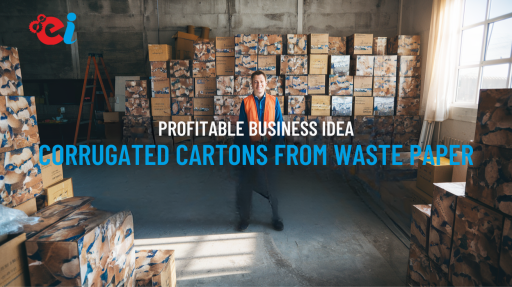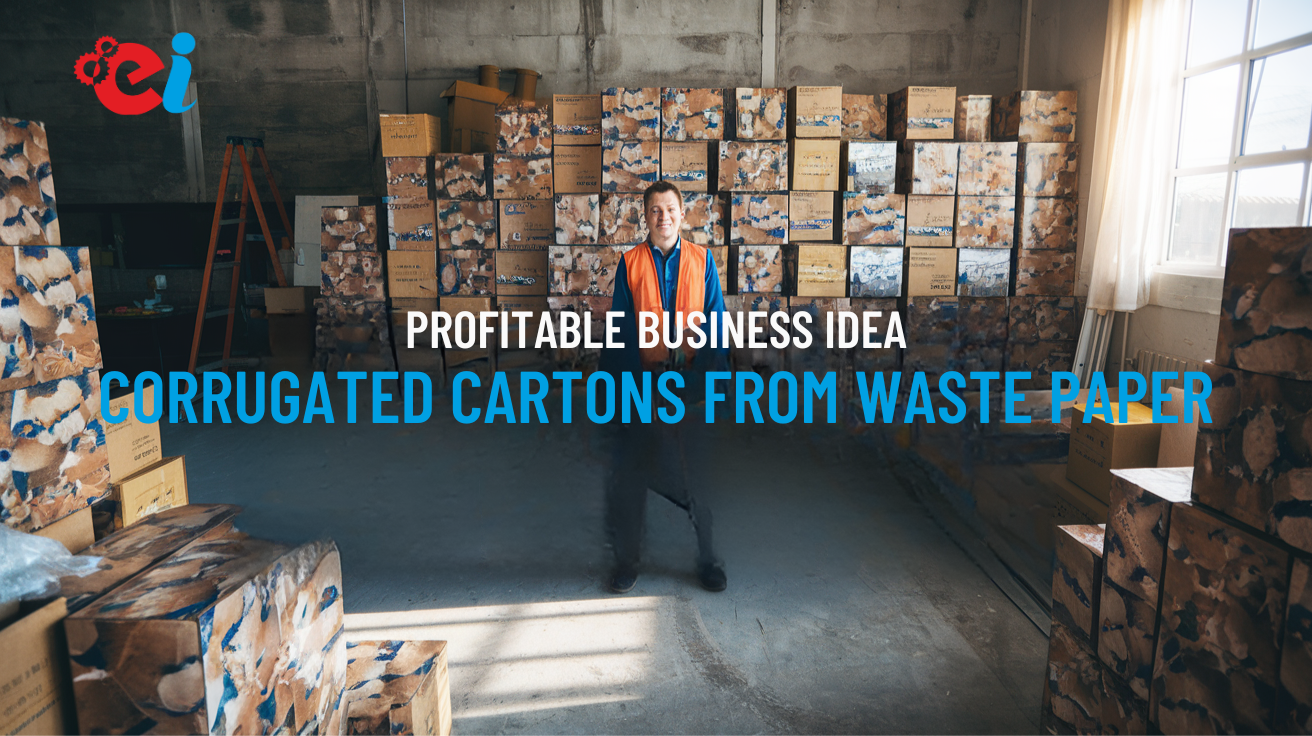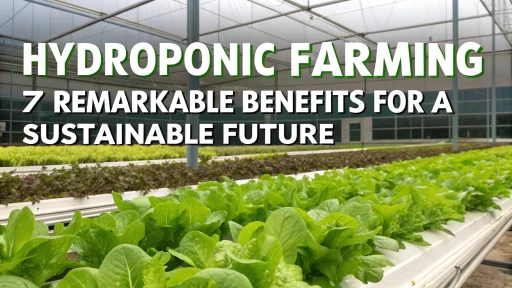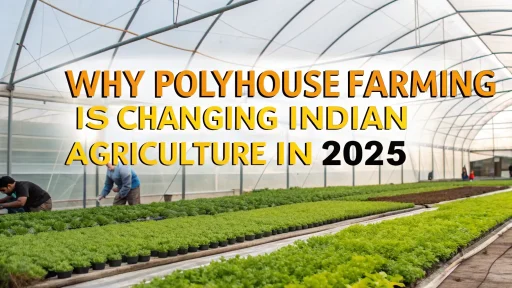Profitable Business: Corrugated Cartons from Waste Paper
Introduction
Packaging solutions come from corrugated cartons. Waste paper recycling allows a company to operate in an environmentally sustainable manner. Low investment and high demand increase profitability. Businesses require eco-friendly packaging solutions. The use of recycled cartons serves as a method to decrease environmental harm. The market demand creates stable conditions for business expansion.
Meaning
The durability of corrugated cartons rests with their light weights. The production process makes use of paper materials recovered from previous use. Manufacturing cartons follows three steps, which include pulping and pressing materials before final shaping occurs. These cartons provide excellent cushioning. Companies depend on these containers to secure their delivered products. Manufacturing within this sector shows increased growth through sustainable practices.
Market Demand
- E-commerce Sector Demand
Online businesses require safe packaging. Lightweight cartons ensure cost-effective shipping. Growing e-commerce boosts demand. Package longevity serves as an essential requirement during all logistics operations. Companies prefer recyclable materials. Custom-sized cartons improve packaging efficiency.
- FMCG Industry Usage
Food and beverage manufacturing sectors require resilient cartons for their applications. Corrugated packaging keeps products safe. Customized boxes increase branding opportunities. Retail packaging requires durable solutions. Sustainable materials reduce environmental harm. Businesses prefer cost-effective options.
- Manufacturing Industry Needs
Factories need sturdy packaging. Fragile goods require shock-absorbing cartons. Industrial growth ensures continuous demand. Manufacturing units require bulk orders. Heavy machinery needs durable boxes. The industrial demand lives on at a constant level throughout all industries.
- Sustainability Trends
Eco-friendly packaging is preferred worldwide. Waste paper recycling reduces pollution. Governments support biodegradable packaging solutions. Businesses follow sustainability regulations. Consumers prefer environmentally friendly packaging. Recycling efforts strengthen industry growth.
Also Read: Plastic Corrugated Sheet & Boxes
Investment and Setup
- Initial Capital Requirements
The establishment expenses for starting a packaging business lie between 10 lakh and 15 lakh rupees. The investment costs include buying machinery along with obtaining land and paying labor costs. Financial planning ensures smooth operations. Investors support sustainable businesses. The market offers inexpensive solutions suitable for businesses operating at a small scale. The market demand accelerates profit generation in the business.
- Required Machinery
The production process requires two key machines, which are pulping units and dryers. Corrugation machines shape sheets. Printing equipment enhances product appeal. Automated systems improve efficiency. Modern technology reduces labor costs. Regular maintenance ensures consistent output.
- Raw Material Sourcing
The recycling centers provide waste paper materials for reuse. Adhesives and inks are affordable. Bulk purchasing reduces costs. Paper mills provide continuous supply. The market offers possibilities for importing materials that have higher quality standards. A company with a solid supplier base enables continuous production.
- Government Incentives
Subsidies support eco-friendly businesses. Low-interest loans help new entrepreneurs. Policies encourage sustainable practices. Government initiatives promote recycling. Business grants are available. Green businesses receive tax benefits.
Also Know About : Pulp and Paper Processing Industry as a Successful …
Manufacturing Process
- Waste Paper Collection
The production facility collects waste paper from supplier networks. Recycling units provide raw materials. Proper sorting ensures quality production. The strength of end products directly depends on the paper quality used during production. Collection networks improve efficiency. The use of better manufacturing materials results in improved profitability.
- Pulping and Cleaning
The raw material begins as waste paper, which turns into pulp. Impurities are removed for strength. The final product shows better quality when using pulp, which has no impurities. Advanced techniques enhance durability. Proper pulping prevents defects. The process maintains industry standards.
- Sheet Formation
The pulp receives pressure that forms flat sheets. Drying strengthens the material. Even thickness ensures uniformity. Proper pressing ensures high strength. Consistent moisture control enhances quality. The drying process affects durability.
- Corrugation Process
Sheets undergo corrugation for durability. Multiple layers provide shock absorption. The process increases carton strength. Specialized rollers enhance rigidity. The corrugated layer improves resistance. The method ensures high-impact protection.
- Cutting and Shaping
Machine operators divide sheets according to required dimensions. Machines ensure precision and accuracy. Proper shaping enhances usability. Automation improves efficiency. Standardized sizes reduce waste. Customization options increase revenue.
- Printing and Finishing
Logos and details are printed. Branding improves product recognition. Water-based inks ensure eco-friendliness. Custom prints attract buyers. Durable prints prevent smudging. High-quality finishing improves customer satisfaction.
- Quality Check and Packaging
Finished cartons undergo quality testing. Strength and durability are verified. Packaging begins when products obtain approval for distribution. Industry standards guide inspections. Defect-free cartons ensure reliability. Proper packaging prevents damages.
Profitability Factors
- Low Raw Material Cost
Waste paper is inexpensive. Sourcing in bulk reduces costs. The implementation of efficient management leads to increased profit margins. Recycling lowers expenses. Cost-effective adhesives improve strength. Profitable pricing ensures business success.
- High Market Demand
Packaging needs keep rising. Businesses prefer cost-effective cartons. Multiple sectors maintain steady customer needs for their products. Corrugated boxes suit multiple uses. Growth trends increase opportunities. The industry sees consistent expansion.
- Government Support
Green businesses receive financial benefits. Tax incentives support recycling industries. Compliance ensures regulatory ease. Sustainability efforts gain recognition. Business-friendly policies encourage growth. Subsidies improve affordability.
- Multiple Revenue Streams
Customization adds value. Printed cartons attract branding clients. Bulk orders ensure higher profits. Specialized designs increase appeal. Retail packaging enhances marketing. Additional services boost revenue.
Challenges and Solutions
- Raw Material Sourcing
Paper availability fluctuates. Reliable suppliers ensure continuous production. Storage planning minimizes shortages. Price variations affect supply. Alternative sources stabilize operations. Proper forecasting reduces risks.
- Machinery Maintenance
Machines require regular servicing. Proper upkeep ensures smooth operations. Trained staff prevent breakdowns. Routine checks improve longevity. Spare parts reduce downtime. Efficient servicing ensures consistency.
- Market Competition
Many manufacturers exist. Unique designs create differentiation. Quality service ensures customer retention. Branding strengthens market position. Competitive pricing attracts buyers. Long-term partnerships ensure stability.
Future Growth
- E-commerce Expansion
Online shopping is growing. Packaging needs will increase. More shipments require durable cartons. Global markets offer opportunities. Rising orders demand innovation. Businesses invest in better materials.
- Biodegradable Packaging Laws
Regulations favor sustainable products. Corrugated cartons meet eco-friendly standards. Businesses shift toward green packaging. Compliance ensures market trust. New laws promote paper recycling. Sustainable trends improve adoption.
- Automation in Production
Technology improves efficiency. Automated machines reduce manual labor. Faster production ensures cost savings. AI enhances workflow. Smart factories boost productivity. Robotics improves precision.






